When synthesists talk of organic sounds they tend to be referring to analogue synths, usually some unstable old beast with wonky voltage controlled oscillators. Organic is rarely deployed to describe digital synths, yet by deploying a range of synthesis options including physical synthesis the Anyma Phi could be staking a claim to the description of organic. How well does it succeed?
The Anyma Phi comes from a small French company Aodyo and started life as a Kickstarter campaign last year with a video cheekily featuring the Korg Prophecy being used as keyboard controller. Cheeky because the Korg Prophecy was one of the first physical modelling synths. People noticed on the forums and remarked that the Anyma Phi appeared to be the first standalone physical modelling (pm) synth in years. However, as you’ll see this isn’t quite true…
The Physical Evidence
Things got off to a good start as the Anyma Phi arrived remarkably close to the projected delivery date. The instrument is a chunky bent steel case in a colour that I can only describe as pearl. The front is adorned with four encoders dedicated to matrix style editing, an encoder for scrolling through patches and a volume knob. There is a miniscule OLED screen. Welcome news round the back – a proper power switch, lines out (right and left), a line in a stereo out on quarter in sockets. There is 5 pin midi in and out, a USB A host socket (meaning it will accept midi directly from a USB device) and a smaller USB B type socket (for connecting to a p.c.). Not apparent from the outside is that the device also has a contact mic built in, for triggering the onboard synth. This makes sense for some of the percussive sounds, but it’s up to you to guess how much mileage you might get from this.
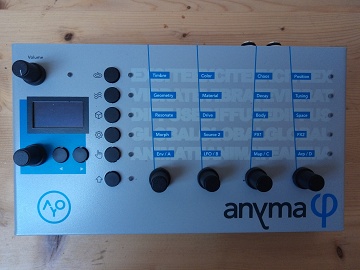
I’m going to get my grumbles out of the way now. No instruction manual of any sort was provided and something had come loose in the device (a piece of solder?) so it rattles when I pick it up. Whilst it came with a USB style (5V) power supply the cable was a measly 50 cm. What is the synthesist’s comfort zone? Within half a metre of the nearest power socket, clearly! The next shock was that the synth comes supplied with a mere seven presets. Not the kind of experience one expects from a mid-price synth.
Under the Hood
Programming pm will be unfamiliar to many, so more presets would have been welcome. Having spent literally minutes exploring the onboard sounds it was time for a trip to the Aodyo’s website, a (painless) firmware update, and an install of the software editor. This is provided at no extra charge and is standalone, sadly no VST plug-in option. The good news is that unlike software editors of the past the editing happens via the USB connection, so a controller can be connected in order to play the synth via the five pin midi socket.
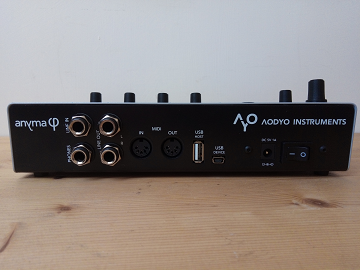
The editor is very good and lays out the underlying synth / processing modules in a straight forward way. In a nutshell the Phi can have up to 3 oscillators. These then pass to up to five ‘effects’. The effects include chorus, phaser, delay and reverb and also other modules that you might not have thought of as effects before including filters, comparators; wave folders; ring modulators; cross faders and two special (and lovely) resonators. The latter are based upon the open source designs of Emilie Gillet. There is a modal resonator which sounds like a physical object, the properties of which can be changed in real time, at one moment glassy, then woody, metallic, plastic – a range of objects suggest themselves. There is also a parameter for damping, brightness and position, the latter a simulation of where the object is excited. The other resonator is the self-explanatory string resonator (with similar parameters to the modal resonator).
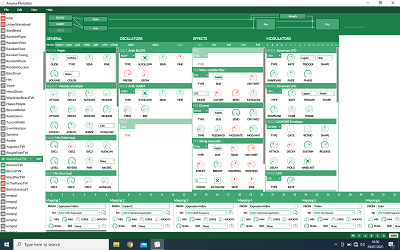
Our quick overview isn’t yet finished as there are 32 modulation slots. Sources can include external midi cc’s such as velocity, note number, mod wheel and after touch. Internal sources can be from up to 16 freely assignable internal modulation sources mainly LFO’s and envelopes.
There are two buses, a main bus and an auxiliary bus, at the end of which is a reverb.
Going Modular
With some justification Anyma say that the Phi is similar to a modular synth. You select your oscillators, choose your effects then bring the whole thing to life with modulation. The way the modulation works in the editor is well implemented; right click on a parameter knob and it will show you what is modulating it, and give you the option of adding further modulations. Modulations are animated, so you’ll see the knob move if, say you route an LFO to it. Modulations can be at variable depth, both positive and negative and also include what Anyma refer to as a side chain. For instance, if the side chain was an envelope the amplitude of the modulation would be in proportion to the envelope amplitude. This is a route to bringing in varying depths of LFO modulations for instance. Modulators can also route other modulators – plenty of depth
I’ve touched upon some of the unusual modules in the overview of the effects and the oscillators also warrant an honourable mention. There are five categories:
1. Physical modelling – covering Wind, reed, flutes, plucked and bowed strings
2. Percussive – included modelled objects, cymbals, bass drum, snare and bell
3. Analogue – sine, pulse, triangle, sawtooth and sub wave
4. Digital – Various vowel / speech models and simple additive models
5. Noise – white noise, filtered varieties and exotica such as a particle system generator
As you can have up to three per patch, there is a lot of scope for unusual timbres before even the effects are applied.
Having put together your synth modules you will want to control them in some way. This is where you can bring the rotary encoders on the unit into play by choosing them as modulation sources and pointing them to the parameter of your choice. The front panel of the Phi has labels suggesting what the encoders will do according to which row of the ‘matrix’ is selected. Each row is selected via buttons to the left hand side, and each also has labels such as exciter, vibrate, diffuse and so on. Navigating around the matrix is simple, much in line with Waldorf instruments like the Blofeld. The labels in each position of the matrix are called things like timbre, colour, chaos and geometry. It’s clear we’re not in Kansas now, Toto.
Depending on the underlying synth engine there may, or may not be parameters which map to the knobs. I started by throwing together some physical model type sounds and mapping the relevant knobs to parameters, but after a while realised that this didn’t work for most non-pm modules. I then threw together random modules and random assignments using up all the available modulations and produced sounds that were at times familiar, other times alien, often somewhat unpredictable and dare I say it organic.
Many of the physical models are very pleasing indeed, and I particularly liked the ability to inject some grit courtesy of the wavefolders, XOR comparators and the like. I mustered forth wonky gamelan, ethereal celestes, spaceship rumbles, spinettes, electric pianos, ugly leads and twisting noises that sound like they were miked inside their own body.
It’s not all Peace in the Valley
The editor software behaved well although on one or two occasions it lost connection the instrument. It has (an ever welcome) undo feature and remembers some of the modulation routings when you swap modules in and out, for instance if you were modulating an oscillator’s pitch and decided to try swapping the oscillator for another, the modulation would be retained. Nearly always this was a helpful, time saving feature. As there are so few presets in the shipped unit a randomise feature would be really welcome. I would envisage that random swapping aspects of the synth e.g. visible parameters, modulation routings, oscillator types, effect types and so on would be more useful than wholesale randomisation.
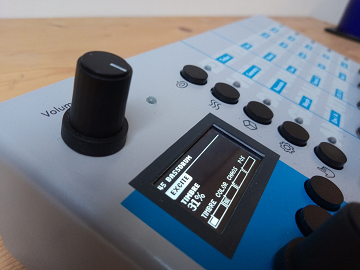
I’ve spent a lot of the review going over the editor, partly because it is the clearest route to understanding the Phi. It is possible to programme the Phi from the front panel – to do so involves burrowing down into the layers of the synth, it’s easy to lose your way. It puts me in mind of digging yet deeper into the Wavestation SR, only here the screen is smaller than a postage stamp. I won’t be attempting this any time soon. In part Aodyo have been creative with the use of such a small screen area, yet in other aspects fall short – there isn’t even a button to save your sounds – possible only through a combination of presses of the obscurely labelled buttons.
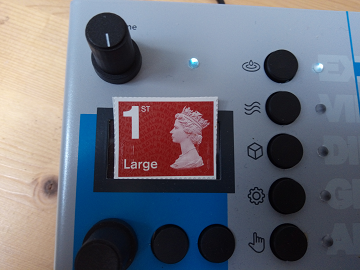
In reality I’ll be stocking this with sounds (you can store up to 200) and doing the best I can with the matrix editor. This is a little bit disappointing as I like hardware synths as they get me away from a computer.
Most of the modules which form the fundamental building block of a patch are decent quality with the exception of the delay and chorus who were clearly last in line for the mojo rations and the reverb which is very much worse than most freeware efforts. It is also defiantly mono. There is a work around to obtaining stereo sounds, by panning the main and auxiliary buses and once I had figured it out I was pretty pleased with the results.
Another area for improvement is the way the amplitude envelope is implemented. In short, if you have a long release, it can prevent subsequent notes being registered, and for most of the pm modules the attack phase has little effect. This could be addressed in part with offering options for legato or set to zero as on other synths.
I haven’t touched on the fact that you can process external audio through the unit, nor the fact that it is peculiarly suited for use with a wind controller as the time has come to sum up.
Conclusion
Is the Anyma Phi the first physical modelling synth in years? Not really, for instance the oft overlooked Alesis Fusion (released in 2005) had a couple of physical models, more recently we have Emilie Gillet’s Mutable Instruments Rings, and if you were into eurorack adding Rings to your arsenal would get you close to the Phi experience. However replicating the entirety of the Phi’s offering in eurorack would be incredibly expensive as it has so many modules. Another instrument sharing some of the Mutable Instruments open source is the Arturia Microfreak. For less money the Microfreak brings a strange capacitive keyboard, an analogue filter, more user friendly programming and a single oscillator in contrast to the three available on the Anyma Phi). I think the Microfreak tends to sound thin, but with the spare change you could pick up an effects box for it.
After many hours programming the Phi, the thought occurred to me – have I just bought into an expensive dongle? No, the Phi is very much more than that – the ability to have these sounds to hand, away from a computer is welcome, and Anyma’s claim to modular complexity is close to the point. The Anyma Phi is also taking care of the processing, leaving your computer free for other duties and in some ways the Phi is like Nord’s micro-modular. Players of electronic wind instruments may also want to take a close listen to the Phi as Aodyo have experience of electronic wind instrument design and have considered the needs of these players by the inclusion of USB midi hosting and the way it responds to continuous controllers.
I’m not going to dedicate hours to programming it from the unit itself, which sadly means that when the editor is no longer supported I will be looking to sell on the Anyma Phi. Until then I’ll be enjoying its exciting, exotic tones.
About the demos: All the demos in this review were recorded straight to Audacity, then normalised to -1dB. No external processing was used. Having recorded some of the demos I noticed ground loop interference owing to having the USB cable to the computer still connected. Once this was disconnected the loop disappeared, though sadly this is still audible on some of the demos. Nevertheless I hope it gives an impression of the sort of sounds the Anyma Phi can produce.
Download the patches: Prior to preparing this article I programmed 57 patches. These aim to cover a wider range of sounds than provided with the original unit and are mapped to the front panel controls on the Anyma Phi. They are available for download here and could be a good basis for your own explorations with the Anyma Phi. Unzip the patches, then using the software editor choose import patch.
These patches are wonderful! Thanks for taking time to post your results here for others to take advantage of. I am also a Phi early adopter and this has really helped me use the instrument while waiting for Aodyo’s official patches to come out. Love the Rhodes and all the stuff that sounds like instruments “miked inside their own body”. A+
I just bought one used. Thanks so much for these patches ~~ excited to play around with them. I hadn’t been able to find much opinion overall on the unit but these patches sound great to me and only further my initial feeling that that there’s something that really stands out with the character in the sounds you can get with this ~ at least that my ears want to hear. I’m not getting into eurorack or investing in a Buchla any time soon so I feel like this will really get me some of the sounds I like hearing.
Thank you very much indeed for your generous offering of patches! I’ve just got myself the little beast -and a Sylphyo- and was not very happy to hear that the firm is gone.
Any clue of Anyma Phy forums around?
Best wishes!!